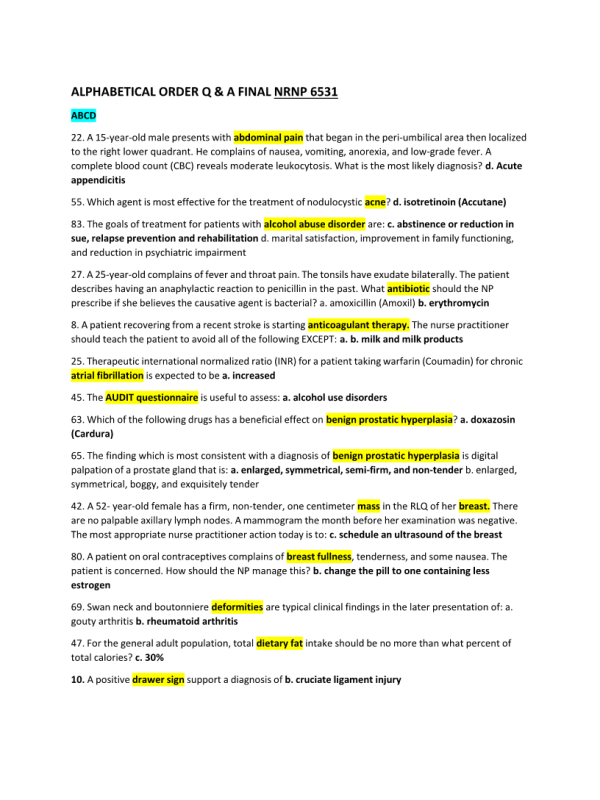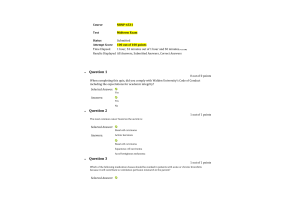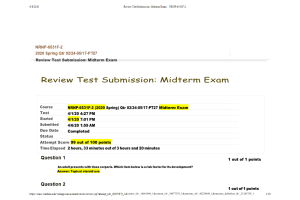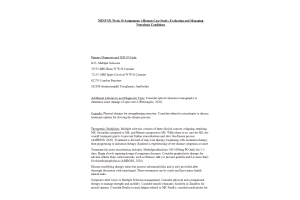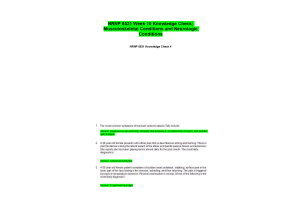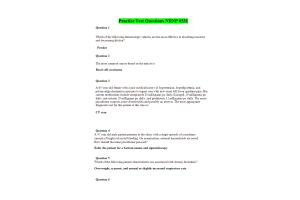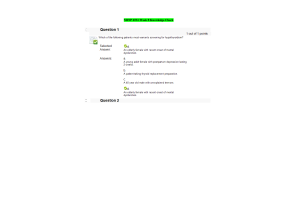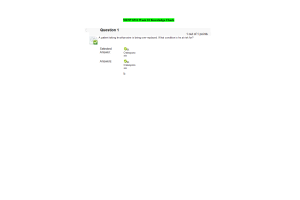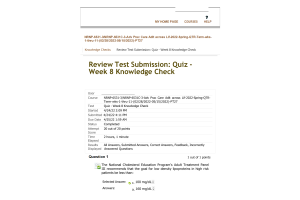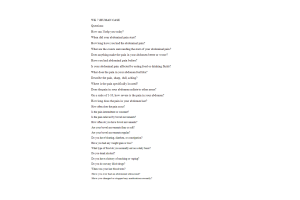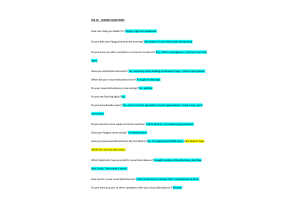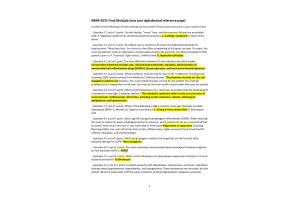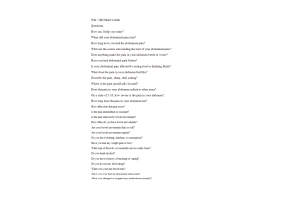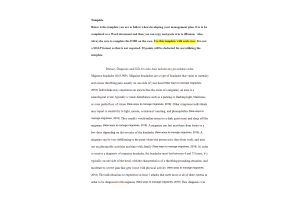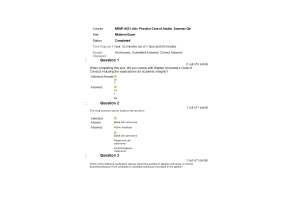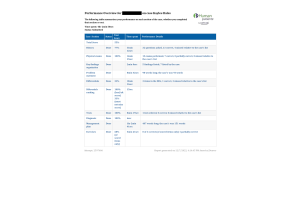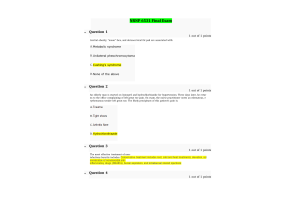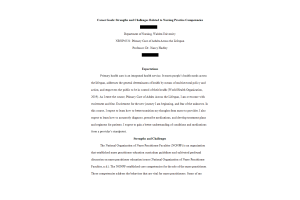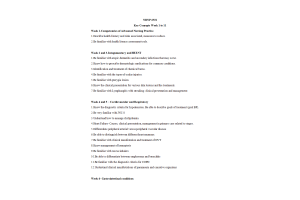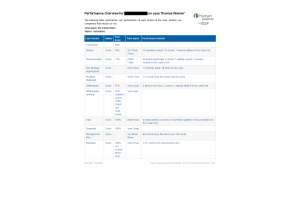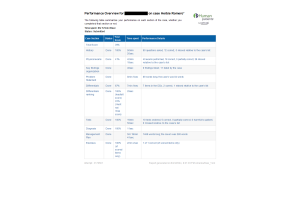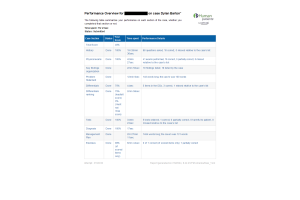NRNP 6531 Week 11 Final Exam (ALPHABETICAL ORDER Q & A)
- $65.00
ABCD
22. Question: A 15-year-old male presents with abdominal pain that began in the peri-umbilical area then localized to the right lower quadrant. He complains of nausea, vomiting, anorexia, and low-grade fever. A complete blood count (CBC) reveals moderate leukocytosis. What is the most likely diagnosis?
55. Question: Which agent is most effective for the treatment of nodulocystic acne?
83. Question: The goals of treatment for patients with alcohol abuse disorder are:
27. Question: A 25-year-old complains of fever and throat pain. The tonsils have exudate bilaterally. The patient describes having an anaphylactic reaction to penicillin in the past. What antibiotic should the NP prescribe if she believes the causative agent is bacterial?
8. Question: A patient recovering from a recent stroke is starting anticoagulant therapy. The nurse practitioner should teach the patient to avoid all of the following EXCEPT:
25. Question: Therapeutic international normalized ratio (INR) for a patient taking warfarin (Coumadin) for chronic atrial fibrillation is expected to be:
45. Question: The AUDIT questionnaire is useful to assess:
63. Question: Which of the following drugs has a beneficial effect on benign prostatic hyperplasia?
65. Question: The finding which is most consistent with a diagnosis of benign prostatic hyperplasia is digital palpation of a prostate gland that is:
42. Question: A 52- year-old female has a firm, non-tender, one centimeter mass in the RLQ of her breast. There are no palpable axillary lymph nodes. A mammogram the month before her examination was negative. The most appropriate nurse practitioner action today is to:
80. Question: A patient on oral contraceptives complains of breast fullness, tenderness, and some nausea. The patient is concerned. How should the NP manage this?
69. Question: Swan neck and boutonniere deformities are typical clinical findings in the later presentation of:
47. Question: For the general adult population, total dietary fat intake should be no more than what percent of total calories?
10. Question: A positive drawer sign support a diagnosis of:
DIABETES
11. Question: A 50-year-old patient with diabetes complains of pain bilaterally in her lower legs while walking. The pain disappears at rest. What else would you expect to identify on her lower extremities?
49. Question: Which of the following patients is most likely to have a diagnosis of Type 2 diabetes mellitus?
19. Question: Which of the following is NOT associated with Type 2 diabetes mellitus?
71. Question: A hemoglobin AIC level is 7.2 in a patient with Type 2 diabetes mellitus. The patient is currently taking a sulfonylurea medication. Which of the following drug should be added next to the medication regime?
78. Question: Which of the following are characteristic of patients with Type 2 diabetes mellitus?
61. Question: Moderate weight loss, particularly of visceral adipose tissue, in patients with Type 2 diabetes mellitus may have all of the following beneficial effects EXCEPT:
81. Question: A 62-year-old with Type 2 diabetes mellitus complains of increased nocturia, fatigue, and weakness. His fasting blood glucose is 110 mg/dL (6.2 mmol/L), he is slightly anemic and his serum creatinine level is slightly elevated. All other laboratory tests and physical examination are within normal limits. What is the most likely diagnosis?
EFGHI
77. Question: A 43-year-old female patient complains of dull ache around both ankles after a day’s work as a cashier. Her symptoms are relieved by sitting and elevating her legs. She reports ankle edema at the end of the day. What is the most likely cause of these problems?
59. Question: Expected spirometry readings when the patient has chronic emphysema include:
7. Question: A 35-year-old female with a history of mitral valve prolapse is scheduled for routine dental cleaning. According to the 2007 American Association’s guideline for endocarditis prophylaxis, what would you advise this patient?
37. Question: A 64-year-old female has sudden onset of right eye pain, blurred vision, and dilated pupil. The most likely diagnosis is acute:
34. Question: A 43-year-old male presents with a large and painful furuncle, the 3rd one in the past 6 months. The NP should do all of the following EXCEPT: b. prescription of a prophylactic antibiotic72. A patient with a diagnosis of giardiasis is being treated with metronidazole (Flagyl). What information would be important to obtain before prescribing this medication?
79. Question: The sexual partner of a symptomatic male patient with gonorrhea should be empirically treated:
32. Question: A 43-year-old has chronic gout. He comes to the clinic for the 3rd time in as many months for treatment of an exacerbation. Dietary counseling should include avoidance of all of the following EXCEPT:
33. Question: A 57-year-old patient presents for an annual physical exam. He reports having 3 attacks of acute gout during the past year. He does not take any medication except NSAIDs during the attacks which help “a little bit.” The NP would appropriately recommend.
20. Question: A 35-year-old male presents with a severe unilateral headache over his left eye. He says it started about one hour ago and has rapidly gotten worse. He gives a history of similar headaches over the past 2 years. Physical examination is negative except for left eye lacrimation. What isthe most likely diagnosis?
60. Question: Right-sided heart failure is characterized by all of the following clinical findings EXCEPT:
43. Question: Which of the following is NOT a characteristic of the S3 heartsound?
76. Question: A nurse practitioner has just diagnosed a patient as having acute hepatitis B. The principle which prohibits the nurse practitioner from notifying the patient’s spouse without permission is:
68. Question: A 65-year-old African American patient was screened at his local church for “high cholesterol.” His total cholesterol (no-fasting) was 215 mg/dL (5.6 mmol/L). What action below is most appropriate for the NP?
28. Question: A diagnostic finding of Hodgkin’s lymphoma is the presence of
4. Question: Which of the following drug classes may potentiate hyperkalemia in a patient taking a potassiumsparing supplement?
18. Question: A 60-year-old male patient with a past history of glaucoma and frequent sinusitis presents today with hypertension. On his last 2 visits to the clinic his blood pressures were 150-160/90-98. The nurse practitioner decides to treat the hypertension with long-acting propranolol (Inderal). Before prescribing it, the nurse practitioner should ask:
64. Question: A 46-year-old female has hypertension and is well managed with propranolol (Inderal). Which of the following is a beneficial secondary effect of this drug?
23. Question: A 25-year-old hypertensive patient has a BMI of 16. His blood pressure is 165/100. There is an audible bruit in his left upper abdominal quadrant. He probably has:
56. Question: Which of the following signs and symptoms is typical of hyperthyroidism?
17. Question: What information should patients with diabetes and their families receive about hypoglycemia?
16. Question: Which drugs below would be expected to produce the least amount of hypokalemia?
1. Question: A 37-year-old female patient with a history of a single episode of depression and frequent complaints of PMS is being treated for hypothyroidism. Today she complains of poor concentration and fatigue. Initially, the NP should:
31. Question: Simple cases of impetigo and folliculitis are usually successfully treated with:
67. Question: The daughter of a 75-year-old patient reports that her mother roams the house at night saying she cannot fall asleep. She has fallen twice. Of the following choices, which would be the most appropriate to treat her insomnia?
86. Question: The anatomicalsite currently believed to be the best location for subcutaneous insulin administration is the:
52. Question: Which of the following is NOT a symptom of irritable bowel syndrome?
JKLMN
46. Question: A 32- year-old mother and her 10-year-old child each have a 10 cm round, reddened patch on the trunk. There is central clearing in the lesion. Different lesions run parallel to each other in a Christmas tree pattern. The mother has been treating the “ringworm” with an anti-fungal cream for 7 days without success. The NP best response is:
58. Question: A young female reports onset of right flank pain 2 days ago that is now severe. Last night she discovered a “burning rash” in the same area. The NP identifies popular fluid-filled lesions that are confluent and follow a linear distribution along the T-8 dermatome. The NP would appropriately order:
66. Question: A 20-year-old male complains of a “skin rash” on his knees and elbows. The lesions have silvery scales and are pruritic. A positive Auspitzsign is present. What is the most likely diagnosis?
82. Question: A 23-year-old female presents with scaly hypo-pigmented macular lesions on her trunk, shoulders, and upper arms. The lesions fluoresce under Wood’s lamp. Appropriate treatment for this condition is:
14. Question: What is an appropriate drug for prophylactic treatment of migraine headaches in a 21-year-old female?
OPQRS
50. Question: Which of the following findings is consistent with otitis externa?
26. Question: A 19-year-old female reportsthat she is having “panic attacks.” The NP knowsthat panic attacks are characterized by:
9. Question: A patient presents with periorbital erythema and edema, fever, and nasal drainage. The nurse practitioner should:
44. Question: A characteristic of elders which affectsthe pharmacotherapeutics of drug therapy in that population is an increase in:
53. Question: An 18-year-old woman is taking a combined hormonal oral contraceptive. She should be instructed to use a backup method for the prevention of pregnancy:
39. Question: An 85 – year-old is diagnosed with shingles. The patient states that she became “miserable” yesterday when the symptomsstarted. What pharmacologic interventionsshould the nurse practitioner offer this patient?
51. Question: The most effective primary prevention of skin cancer is to educate the public about:
29. Question: With a history of ankle sprain, the nurse practitioner would most likely elicit a history of:
73. Question: The nurse practitioner is performing a routine assessment of a 47-year-old female who wants to lose weight. She has truncal obesity with relatively slender forearm and lower legs. Her BMI is 38. Question: Upon review of her history, physical examination, and laboratory reports, the nurse practitioner diagnoses “Syndrome X.” This diagnosis is based on the previous findings plus all of the following EXCEPT:
TUVW
13. Question: A -year-old with Type I diabetes has had itching and burning lesions between her toes for 6 months. Scrapings of the lesion confirm the diagnosis of tinea pedis. What is the best treatment option for this patient?
57. Question: An 83-year-old man has a resting hand tremor. What disease process is this type of tremor is most commonly associated with?
85. Question: A patient haslaboratory studies performed which demonstrate increased TSH, decreased free T4, and T3. Which symptoms might she complain of?
15. Question: Which of the following are the classic features of ulcerative colitis?
21. Question: A 16-year-old sexually active female present to the clinic. She has never had vaccination for hepatitis A or B, she has had one MMR immunization, and her last tetanus vaccination was 4 years ago. Which vaccination would be contraindicated without further testing?
48. Question: A 23-year-old female college student is being evaluated by the nurse practitioner for immunization status. She has documentation of completion of IPV, DTaP, and MMR series. She states, “I got a shot when I was 12 years old, but none since.” Which vaccine(s) should she receive today?
54. Question: A 50-year-old patient has abnormal vaginal bleeding with heavy periods and intermenstrual watery discharge with a small amount of blood. What is the most likely diagnosis?
74. Question: A 59-year-old postmenopausal woman has atrophic vaginitis. She has a history of breast cancer at age 40 years. What is the appropriate initial treatment for this patient?
12. Question: A 16-year-old athlete complains of pain underneath his heel every time he walks. There is a verrucous surface level with the skin of the heel. What pharmacologic interventions should the nurse practitioner prescribe for this patient?
38. Question: A 25-year-old patient presents with complaints of pain and burning in the vulvar area. Upon examination, the NP notices vesicles with an erythematous base arranged in a group on the patient’s labia major. The most likely diagnosis is:
XYZ
ADOLESCENTS:
24. Question: Which of the following is the most common presenting sign of substance abuse in adolescents?
70. Question: A 13- year-old patient complains that he fell while running during football practice. Now his knee hurts and sometimes “locks.” The NP conducts McMurray’s test. Which of the following is TRUE about this test?
LEGAL/FNP
30. Question: Certification for nurse practitionersis offered through:
75. Question: The process by which a profession association confers recognition that a licensed profession has demonstrated mastery of a specialist body of knowledge and skills is termed:
41. Question: The mechanism by which nurses are held accountable for practice, based on the quality of nursing care in a given situation in accordance with established standards of practice, is:
40. Question: A 16-year-old presents to the clinic for a scheduled immunization. The patient is unaccompanied by an adult. The NPs action is based on the knowledge that:
62. Question: Nurse practitioner services are filed with Medicare for reimbursement
